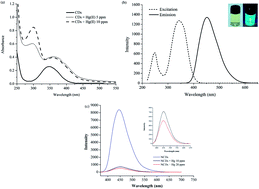Sensitive distance-based paper-based quantification of mercury ions using carbon nanodots and heating-based preconcentration†
Abstract
This article reports the first fluorescent distance-based paper device coupled with an evaporating preconcentration system for determining trace mercury ions (Hg2+) in water. The fluorescent nitrogen-doped carbon dots (NCDs) were synthesized by a one-step microwave method using citric acid and ethylenediamine. The fluorescence turn-off of the NCDs in the presence of Hg2+ was visualized with a common black light, and the distance of the quenched fluorescence correlated to Hg2+ concentration. The optimal conditions for pH, NCD concentration, sample volume, and reaction time were investigated. Heating preconcentration was used to improve the detection limits of the fluorescent distance-based paper device by a factor of 100. Under the optimal conditions, the naked eye limit of detection (LOD) was 5 μg L−1 Hg2+. This LOD is sufficient for monitoring drinking water where the maximum allowable mercury level is 6 μg L−1 as established by the World Health Organization (WHO). The fluorescent distance-based paper device was successfully applied for Hg2+ quantification in water samples without interference from other cations. The proposed method provides several advantages over atomic absorption spectroscopy including ease of use, inexpensive material and fabrication, and portability. In addition, the devices are simple to fabricate and have a long shelf-life (>5 months).



 Please wait while we load your content...
Please wait while we load your content...